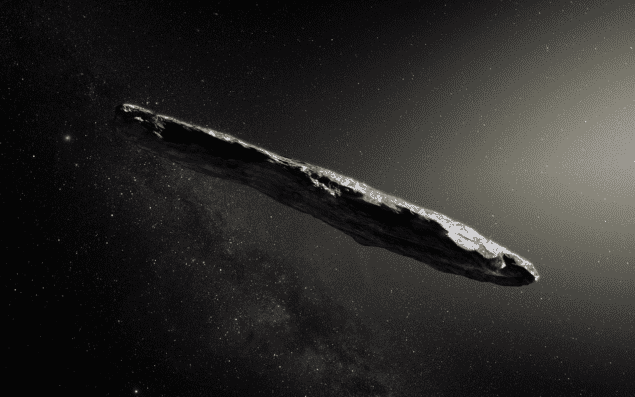Is interstellar object ‘Oumuamua an alien space probe?
07 Nov 2018 Hamish Johnston
The interstellar object ‘Oumuamua could be a “light-sail” created by an alien civilization. That is the highly speculative conclusion of Shmuel Bialy and Avi Loeb of Harvard University, who say that the unexplained trajectory of the object as it travelled through the solar system could be the result of it being accelerated by sunlight.

In a statement about the research, Loeb says that it is “unclear whether ‘Oumuamua might be a defunct technological debris of equipment that is not operational any more or whether it is functional”. Bialy and Loeb believe the object could be a light-sail, which would have used the radiation pressure of starlight – or perhaps even light from a giant laser – to reach the solar system. Japan’s IKAROS mission, which launched in 2010, has already used a light-sail to accelerate a spacecraft using sunlight.
First spotted in October 2017 by the Hawaii-based Pan-STARRS survey telescope, ‘Oumuamua appears to be a highly elongated, 230 m-long object that originated from outside the solar system. Named after the Hawaiian word for “scout” to commemorate its interstellar voyage, the cigar-shaped object has both a highly eccentric orbit and a shiny surface, leading some astronomers to identify it as a comet. However, the lack of a coma of gas and dust around ‘Oumuamua suggested to others that it is an asteroid.
Rotational stability
In June 2018, Marco Micheli of the European Space Agency and colleagues showed that the trajectory of the object through the solar system cannot be explained solely by the gravitational attraction of the Sun, planets and large asteroids. Instead, the team suggested that outgassing was propelling ‘Oumuamua – making it a comet. Then in October 2018, Roman Rafikov at the University of Cambridge argued that the object is far too rotationally stable to have comet-like ejections of gas
Now in a paper accepted for publication next week in The Astrophysical Journal Letters, Bialy and Loeb suggest that ‘Oumuamua could be a piece of technology created by an alien civilization. Indeed, they write that “‘Oumuamua may be a fully operational probe sent intentionally to Earth vicinity by an alien civilization,” with the caveat that this is an “exotic scenario”.
In their paper, which has been peer reviewed, the astronomers show that ‘Oumuamua’s trajectory can be explained by the acceleration caused by sunlight reflecting from the object. For this to happen, however, ‘Oumuamua must less than 1 mm thick and be just a few metres across – which is much smaller and thinner than previously thought.
Highly reflective
To support their claim, Bialy and Loeb point out that resolved images of ‘Oumuamua are not available and that estimates of its size and shape are based on the amount of light reflected by the object as it tumbles through the solar system. However, the lack of infrared emissions from the ‘Oumuamua suggest that it is much more reflective than previously thought – and therefore could be much smaller than previous estimates, they argue.
Instead of being 230 m long, they suggest that ‘Oumuamua could be just a few tens of metres long. They also say the object could be shaped like a sheet, which the astronomers claim would be consistent with the observed tumbling motion of the object. Bialy and Loeb say, however, that ‘Oumuamua need not be flat, but could be a curved sheet, hollow cone or even a sheet that has been folded up like an umbrella.
Random origin
Loeb says that if ‘Oumuamua is an asteroid from another star that arrived here by random chance, then each star in the Milky Way would have to have about 1015 similar objects associated with it. This number is much higher than a theoretical calculation of asteroid numbers done a decade ago by Loeb and collaborators, suggesting that a natural origin is very unlikely.READ MORE

Bialy and Loeb are not the first to suggest that ‘Oumuamua could be an alien spacecraft. Indeed, researchers from the SETI Institute scanned the object for radio emissions when it passed near Earth in 2017, although none were found.
Unfortunately, ‘Oumuamua is now too far away from Earth to study further so we may never know its precise nature and origin. Loeb says that astronomers should be scanning the sky for other interstellar objects, including possible light-sails.
A preprint of the paper is available on arXiv.
7/11/2018 FROM PHYSICSWORLD.COM

Δεν υπάρχουν σχόλια:
Δημοσίευση σχολίου